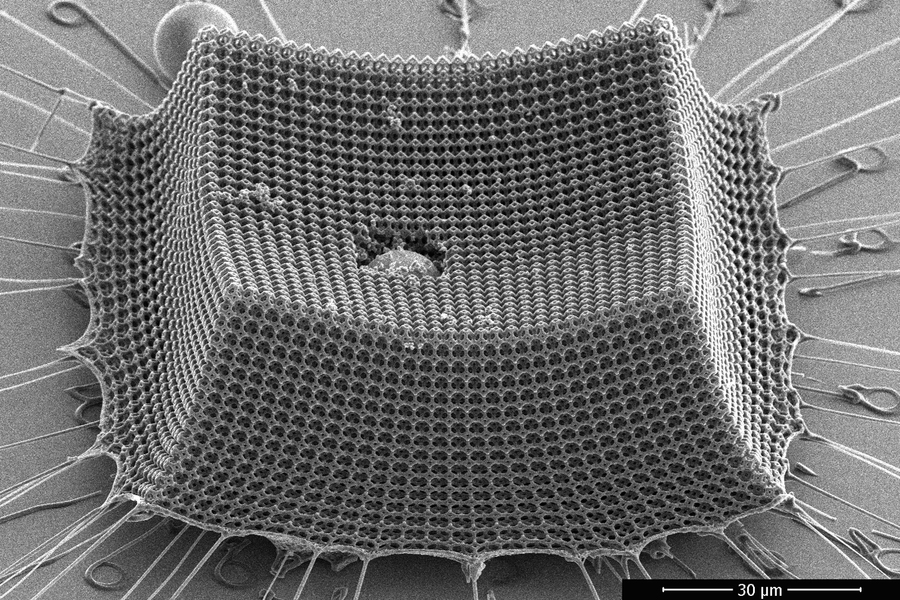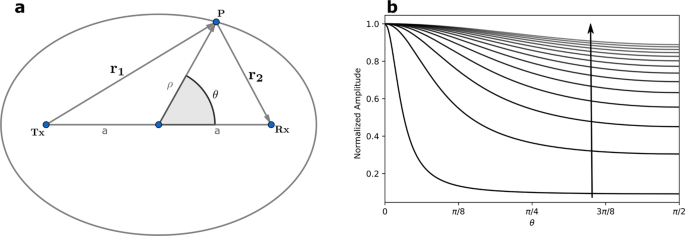2021-06-24 アメリカ合衆国・マサチューセッツ工科大学(MIT)

・ MIT、カリフォルニア工科大学(Caltech)およびチューリッヒ工科大学(ETH Zürich)が、微粒子の超音速衝撃を耐久するナノ構造材料の新設計を開発。
・ 靱性と機械的耐久性を付与するナノスケールの炭素支柱をベースとした、人間の毛髪の幅よりも薄く超軽量材料の設計原理を提供。同じ重量のスチール、Kevlar、アルミニウム等の耐衝撃性材と比較した場合、新設計の材料ではより効率的に衝撃を吸収する。
・ 大規模製造により、Kevlar やスチールを代替する超軽量で耐衝撃性材料として、防護具、保護コーティング、ブラストシールド等での利用が期待できる。
・ ナノ構造材料は、優れた特性を材料に付与する、パターン化したナノスケールの構造体より構成される。本研究ではこのような材料の高速度衝撃等による高速変形の試験を実施し、極めて高い耐衝撃性を実証した。
・ 微細な支柱から構成される、格子構造の連続したパターンの 14 面体を 2 光子リソグラフィーで感光性樹脂に加工。残存した樹脂の洗浄後、高温度真空炉での焼成によりポリマーを炭素に変換し、超軽量のナノ構造炭素材料を作製。
・ 次に、レーザー照射で起こるプラズマを使用して、14 ミクロン幅のシリコン酸化物粒子を対象物に高速で衝突させるレーザー誘起微粒子衝撃試験を実施し、極度の変形に対する同材料の耐久性を超音速を含む毎秒 40~1,100m の範囲で調査した。
・ 密度の異なる 2 種類のナノ構造炭素材料で試験した結果、炭素支柱が若干厚い材料がより強靭で、微粒子が材料を突き破らずに埋没する傾向を確認。埋没した微粒子と材料の断面状態から、微粒子の底部では微細支柱が潰れて圧縮されていても、その周囲の構造が変わらないことを発見。ナノ支柱による衝撃圧縮の働きで、大量のエネルギーが吸収できることを実証した。
・ バッキンガムのΠ定理を使用する惑星衝突の次元解析フレームワークにより、ナノ構造材料の物性、微粒子のサイズと衝突速度から、実験データが示した衝撃を予測できることも確認。他のナノ構造材料での予測にも利用できる。
・ より強靭で軽量な保護材料の設計開発を目標に、今後も様々なナノ構造や炭素以外の材料とそれらの製造のスケールアップについて研究を進める。
・ 本研究は、米国海軍研究局(ONR)、Vannevar Bush Faculty Fellowship (VBFF)および MIT のInstitute for Soldier Nanotechnologies(ISN)を通じ米国陸軍研究局(ARO)が一部支援した。
URL: https://news.mit.edu/2021/carbon-nanomaterial-light-strong-0624
<NEDO海外技術情報より>
(関連情報)
Nature Materials 掲載論文(アブストラクトのみ:全文は有料)
Supersonic impact resilience of nanoarchitected carbon
URL: https://www.nature.com/articles/s41563-021-01033-z
Abstract
Architected materials with nanoscale features have enabled extreme combinations of properties by exploiting the ultralightweight structural design space together with size-induced mechanical enhancement at small scales. Apart from linear waves in metamaterials, this principle has been restricted to quasi-static properties or to low-speed phenomena, leaving nanoarchitected materials under extreme dynamic conditions largely unexplored. Here, using supersonic microparticle impact experiments, we demonstrate extreme impact energy dissipation in three-dimensional nanoarchitected carbon materials that exhibit mass-normalized energy dissipation superior to that of traditional impact-resistant materials such as steel, aluminium, polymethyl methacrylate and Kevlar. In-situ ultrahigh-speed imaging and post-mortem confocal microscopy reveal consistent mechanisms such as compaction cratering and microparticle capture that enable this superior response. By analogy to planetary impact, we introduce predictive tools for crater formation in these materials using dimensional analysis. These results substantially uncover the dynamic regime over which nanoarchitecture enables the design of ultralightweight, impact-resistant materials that could open the way to design principles for lightweight armour, protective coatings and blast-resistant shields for sensitive electronics.



